DE STAART VAN HET VERHAAL
Oftewel, het verhaal van de Fokkerstaart / beddeplank zoals dat in vereenvoudigde vorm
opgenomen is in "Dutch Super Cubs".
Home Contact Herman Dekker Terug naar de INDEX
Terug naar PH-UAM
Early in 1946 the Rijksluchtvaartschool (R.L.S.) was supplied with a number of Tiger Moths which were acquired by the Netherlands Government from R.A.F. supplies.
They were registered
in the PH-UA*-series.
The flying training was immediately started at Gilze-Rijen airfield
but very soon four of these Tigers crashed, three had to be written off. The aircraft involved were PH-UAA (86585),
PH-UAF (86538), PH-UAH (86506) and PH-UAK (86303).
One pupil was killed.
Investigations about the Tiger Moths' flying characteristics were made and compared with those of the pre-war Tiger Moth of the Nationale Luchtvaart School, the PH-AJG (3190).
It was discovered that the rudder movement was much greater than that of the pre-war example.
Much greater too than was considered acceptable for initial training in the pre-war period. (Lit.1) and (Lit.8). This fact was considered to be the reason that the Tiger Moths used after the war were more easily brought into a spin than the PH AJG.
As a matter of fact, there had been troubles with the aircrafts' flying characteristics in the United Kingdom too! In the massive and intensive training at the beginning of the war several Tiger Moths went into a spin and crashed. To solve this problem the so-called "anti-spin strakes" were fitted, which indeed considerably reduced the time it took to correct the spin but the opinion of the Air Registration Board was not altogether favorable:
"The horizontal stabilizer modification was incorporated at the instigation of Flying Training Command but wether it was really necessary is doubtfull. The reason for the modification was to decrease the time taken for spin recovery but it has been suggested that although they fulfill this function, they also may slightly increase the tendency to spin when near the stall.
Although
this modification was classed as essential by the Flying Training Command it was not considered so by
Air the Registration Board and
is not included in the list of essential modifications which must be incorporated for the issue of a civil Certificate of Airworthiness". (Lit.2)
Another reason for bad flying characteristics was the fact that some aircraft accumulated as much as 30 kg. of paint as a result of repairs or colour-scheme changes.
That extra weight had its consequences of course! (Lit.11)
While waiting for the results of the investigations, the Tiger Moths of the R.L.S. could not be used for primary training. These investigations were carried out by the Nationaal Luchtvaart Laboratorium (N.L.L.) on September 5 and 9, 1946, by ir. S. Wynia from N.L.L., pilot was H.J. van Overvest.
The supervisor of these tests was of course the Rijksluchtvaartdienst (R.L.D.) and
the R.L.D. observer was Mr.
Gosen of the Inspection Department.
One of the aims was to determine the correct maximum movement of the rudder.
The tests were carried out on a Tiger Moth on which the
movement of the rudder was considerably restricted. It had also to be determined
how this aircraft could be brought into
a spin and if there was sufficient rudder movement left for the
other maneuvers. (Lit.1)
In the meantime, one
modification had already been
carried out, the mass balance part of the rudder was deleted and the
fin was enlarged with a similar area.
This modification had improved the flying characteristics slightly but the results of the investigations were not altogether satisfying.
In symmetrical flight, flying straight ahead, the stall characteristics were very good but in turns they were considerably worse. In an outward-slipping turn an excessive difference quickly developed between the angle of attack of the inside and the outside wing. During such a turn the aileron at the inside wingtip is downward which makes the angle of attach still greater. In this way the maximum angle of attack could be surpassed, possibly resulting in a side-slip, or worse, in a side-slip turning into a spin over the downward wing.
These unfavorable characteristics were in sharp contrast with the favorable ones in symmetrical flight. On the side of the pupil pilot this could easily lead to an over judgement of safety when performing an outside-slipping turn.
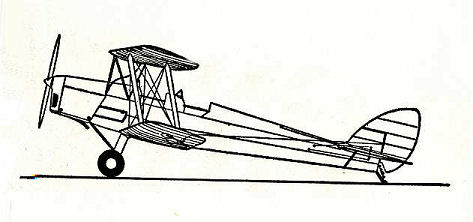
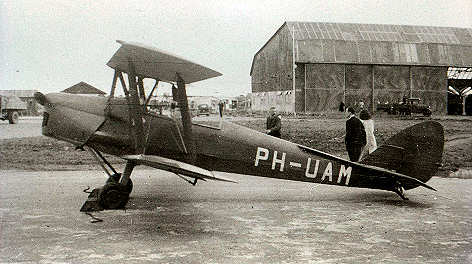
Report V.1388 of the test-flights in September
1946, was concluded on December 9, 1946 and includedthe
above stated facts as well as the following conclusions and comments. (Lit.4)
- The aircraft is directionally unstable while flying with the rudder free. With unrestricted movement of the rudder, it is difficult to control the aircraft with the use of the ailerons and elevator. The resulting unstable movement developes into a spin.
- With restricted rudder movement at speeds above ca. 60 mph. the aircraft is to some extent steerable with a free rudder.
- The aircraft flown with slots free cannot be stalled in symmetrical flight and in true turns by very slowly pulling back the control collumn or, at a 25% higher speed than minimal, by pulling back the control column quickly back, whether in a glide or with some engine power.
- One wing of the aircraft can easily be stalled in slipping flight at speeds much above the minimal for symmetrical flight by pulling back the control column or a further movement of the rudder.
In an outward-slipping turn this results in a side-slip immediately followed by a spin.
In other maneuvers the aircraft first 'went about'. The movements of the aircraft with restricted rudder are very calm.
- The aerodynamic aileron forces are that small, that they are domineered over by the frictional forces. As a result of rudder-movement the tension in the cables increases and, as a consequence, the friction does so too. Measured at the rudder-bar there is an increase from about 0,5 to 2,5 kg.
This is the result of the trapezium of rudder-bar, control-cables and aileron lever.
By movement of the rudder the circumference
of the now distorted trapezium is enlarged causing tension in the cables.
Summarizing, the aircraft in its present form is considered less suitable to be
used as a trainer initial for the following reasons:
1. The pupil does not develop a normal flying sense on the rudder bar.
The spring construction on the rudder has as a disadvantage that the forces on the rudder are depending on the amount of movement and they do not give a natural impression of the aerodynamic forces which occur as a result of loss of speed in a side-slip and in turns. In this connection the following quotation from Instructors Handbook from Directoraat L.S.K. (Lit.5) is characteristic:
"With this in mind, the student should be cautioned never to think of movements of the controls as the factor which determines what the aircraft will do, but only of the exertion of pressure on them against live pressure or resistance".
2. Through manoeuvring errors (not returning the rudder bar into a neutral position after making a turn before landing and at the same time reducing speed or making a tight turn by only using the rudder bar) the aircraft can easily be brought into a side-slip which develops into a spin.
This tendency is enhanced by the characteristics of the aircraft and its steering qualities in this circumstance.
3. The aileron movement is especially inadequate
at low speeds and not in accordance with the rudder.
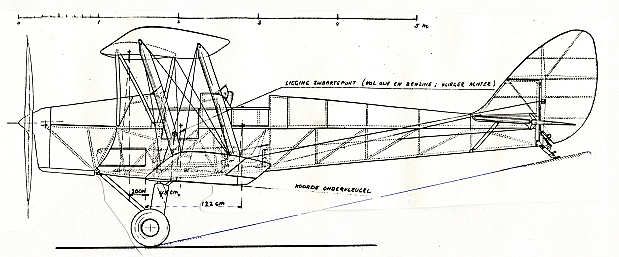
From the Civil Pilot Training Manual (Lit.7) the
following quotation is
taken:
"There is another danger in excessive use of the rudder.
As the aircraft skids, the bank will increase. This often alarms
the pupil when close to the ground
and he applies pressure to the
stick towards the outside of the turn to check the bank. At the same time, the rudder forces
the nose down and the pupil pulls back on the stick to hold
it up. In his general dismay at his apparent inability to handle the slip he is likely to finish up with the stick practically all the way back in one corner and full rudder on the opposite side, a perfect
control setting for a spin".
Report V.1388
finishes with the following remarks:
- With restricted rudder movement the aircraft's safety is improved.
But it becomes even less suitable as a training aircraft because stall turns, aerobatics, cross-wind take-offs and landings cannot be sufficiently practiced.
- The aircraft could be improved and
made safe by further aero dynamical under balancing of the rudder and enlarging
of the fin.
As a result of the experiences
embodied in Report V.1388, a very
extensive flight test program
was conducted on the Tiger Moth to determine
its flying characteristics. As is stated before, the post-war Tiger Moths proved to
possess other flying characteristics than the pre-war PH-AJG which had been used for the Certificate
of Airworthiness tests. To determine the correct current situation, tests were necessary to be able
to recommend changes to the aircraft. The experiences of the test flights also had suggested that the aircraft could
be improved by changing the
design of the fin. (Lit.9)
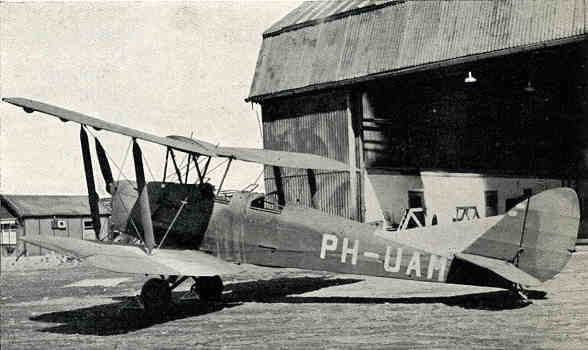
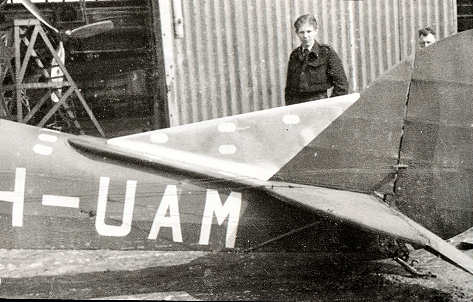
Foto via H. Hooftman Foto Rapport V.1407
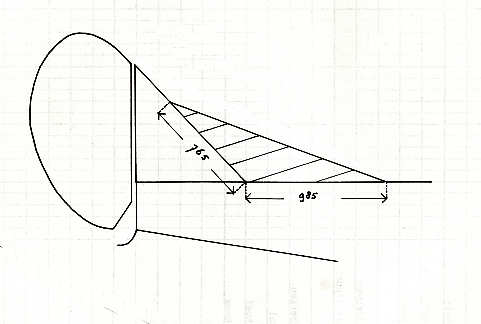
As a result of the suggestions
laid down in Reports V.1388
and V.1406 a practical test was carried
out in which three
different modifications were
tested.
I. Triangular enlargement of the fin. Area enlarged by 0,28 sqm. Anti spin strakes not deleted.
Test flights on 21.03.1947.
II. Fin enlargement
as in version I. Anti spin strakes
deleted. Test flights on 09.04.1947.
III. Triangular enlargement of the fin. Area enlarged by 0,43 sqm.
Test flights on 22.04.1947 and 23.04.1947


Foto Rapport V.1407
The test of versions I and II showed a slight improvement in several aspects. The spin was quickly brought under control by returning the rudder into the central position. It must be stated at this point that the doubts of the Air Registration Board relating to the effect of the anti-spin strakes were confirmed through these tests!
The welknown Dutch flight-instructor Daan Lambermont was given the opportunity to fly version II.
In his opinion there was a marked improvement over the aircraft in its original form. (Lit.9)
The best results were experienced with version III, the version with the modification which became known as the 'Fokker-tail'. In Dutch nicknamed 'de beddeplank'.
The results of these practical tests were laid down in report V.1607 (Lit.9), compiled by ir. T. van Oosterom.
Since the decision
to make this tail-modification obligatory was
taken on the base of this
report, chapter 6 "Summary and
conclusions" is now quoted completely.
"As a result of the investigations of the, from a flight-safety's point of view, principal flyingcharacteristics of the Tiger Moth, the findings of which were published in the N.L.L. Reports V.1388 and V.1406, it was supposed that by enlarging the fin and aerodynamic under balancing the rudder, performance of thethe aircraft could be improved without the disadvantages connected with the restriction of the rudder-movement as originally applied. The investigations carried out by order of the R.L.D. of which the results are laid down in this report indeed point out that this suggestion is correct. The investigated modifications included the enlarging of the fin area, the removing of the balance-area and the static balance of the rudder, while the rudder kept its original form.
These
modifications also had the practical
advantage that a definite modification can simply be applied
to the
other aircraft. The tests were
made with two enlarged fins of different sizes and with
and without anti-spin strakes. The best results were found with the biggest enlargement,
version III, in which the anti-spin strakes were deleted".

Here follows a short summary of the results of the tests with this version.
6.01 Performance with free rudder. In contrast to its earlier performance it now flies (with a trimmed rudder) straight and level with the rudder free. The rudder quickly returns to the central position once it has been released from its extended travel.
6.02 Directional stability with rudder held fast. Here also is a marked improvement, especially when flying in turbulent conditions. The aircraft yawed a lot less as when flown in the original form.
6.03 Side-slip. The aircraft can be side-slipped in the same manner as the original. With total extended ailerons the total movement of the rudder is not necessary. In side-slips with a forward speed of 65 mph. 85% in a left-hand slip and 80% in a right-hand slip. In the original design the rudder movements are smaller.
6.04 Turn stability. Stability in the turns remained the same. The behavior in turns (stick-position and -forces) is now more in conformity with that of more modern aircraft.
6.05 Maneuverability. The maneuverability seems to be slightly less than in the original form.
But it is still possible in powered flight at low speed (60 mph.) to change quickly from a sharp left hand turn into a sharp right hand one while only half the rudder movement is necessary.
The maneuverability in this situation is considered as more than sufficient.
6.06 The spin. To perform a spin out of symmetrical flight, almost full rudder movement is necessary, but when the rudder is returned into the central position the spin is immediately ended.
The aircraft enters calmly into the spin, which is more flexible than in the original form, while the aircraft holds a more vertical position during a prolonged spin. The aircraft loses height at about 90 meters (295 ft.) per turn, at a rate of turn of about 2 seconds.
6.07 Side-slipping turns at minimum speed. For the performing of side-slipping turns at minimal speed the rudder requires a larger movement than was necessary with the original design, while the driving forces are working in the right direction. When the aircraft goes into a stall in these conditions, it goes into a spin slowly (sometimes into a vertical spin). The larger rudder movement and the stick forces working in the right direction make it unlikely that the pupil will stall out of a slide turn while making a landing.
6.08 Aerobatic flights. The slow roll can be much better performed than with the original design, the aircraft does not glide off course. Also, the barrel roll is considerably better than before; the turn and bank indicator shows very little movement. With the Immelmann turn there is no swinging in the downward leg as was often the case in the original form. The flick roll, the half loop and half roll, the inverted roll and looping can be performed without problems; no differences with the old design are recorded.
6.09 Maneuverability on the ground and landing in cross-winds. With cross-winds of 15 to 19 mph. the aircraft can be handled without problems on grass as well as on paved surfaces. Landing with a cross-wind (with a wind speed of 30 km/h. with a sideward force of about 10 km/h.) caused no special problems and can be made with a moderate rudder movement. The greater directional stability gives an improvement here.
6.10 Permissible aft ward centre of gravity other then allowed for in the Certificate of Airworthiness. It was discovered that when the Tiger Moth aircraft was being flown in its normal configuration (two crew, no nose ballast) the centre of gravity was moved aft wards. The most backward permitted position is 34.3 cm. after the leading edge of the underwing close to the fuselage.
But with the modified tail it can move backward to 39.5 cm.
A preliminary investigation into the static horizontal stability in powered flight and glide flight and from the spinning characteristics, have given no objections against the centre of gravity being moved aft ward that far. As soon as a definite modification of the Tiger Moth's tail has taken place,
a new calculation of the centre of gravity will be made and a new investigation into the horizontal stability and spinning characteristics will be necessary. In summing up it can be concluded that not only is the aircraft safer to fly but it is also much more suitable to be used as a trainer.
It is not unlikely -although this has not been investigated- that the aircraft in this form, after a small restriction of the rudder movement can no longer be brought into a spin. The other flying characteristics will probably not prohibit such a restriction.
Remark: It is advised to change the trimming
device on the rudder so that it
can be adjusted
quickly and easily in flight, as is done with the elevator. In this way the pupil will be trained
to keep the aircraft in trim all the times. The trimming spring which is currently installed does not permit to trim the aircraft in flight.



APPENDIX
Constructive suggestions for alterations on the Tiger Moth.
1. Deletion of the anti-spin strakes
2. Deletion of the balance area and the static
balance weight.
3. Replacement of the original tail-fin by a tail-fin of the described dimensions.
The strength of the construction must be strong enough so that
all aerobatic maneuvers can be performed.
The construction has to be as light as possible so that the
centre of gravity will not be
moved too far aft.
4. The trim mechanism
on the rudder must be changed so
that it can
be adjusted quickly and easily
during flight.
Remarks. After the alterations the centre of gravity
of the air craft must be re-calculated and it has to
be determined whether the aircraft
can be used
without nose-ballast. Static
stability and spin characteristics are to be investigated.
A summary of the flight-tests mentioned in this chapter.
TEST
INVESTIGATOR
PILOT
REPORT
Preliminary investigation 1st. phase ir. S.
Wynia H.J. van Overvest V1388
Preliminary ir. S. Wynia investigation and later 2nd. phase:
ir. T. van
Oosterom J.K. Hoekstra V1406
Final investigation ir.
T. van Oosterom J.K. Hoekstra V1407
SOURCES AND
ACKNOWLEDGEMENTS
(1) Letter from Inspectie R.L.D. to director
of R.L.S. dd. 06.09.1946
(2) Letter from Air Registration Board to R.L.D. late 1946
(3) Letter from N.L.L. to R.L.D. dd.
15.01.1947
(4) N.L.L. Report
V.1388 "Qualitative investigation
of the aircraft type Tiger Moth from the
R.L.S. at Gilze-Rijen on 5th. and
9th. September 1946 after accidents
while landing", compiled
by ir. S. Wynia.
(5) Instructors Handbook from Directoraat L.S.K.
(6) Flight Instructors Manual, Civil Aeronautics Bulletin No.5, 3rd. edition, September 1941. U.S. Department
of Commerce. (7) Civil Pilot Training Manual, Civil Aeronautics Bulletin No. 23,
2nd. edition, September
1941. U.S. Department of Commerce.
(8) N.L.L. Report
V.631a, "Reports of tests with
the aircraft PH-AJG, type
Tiger Moth, on 18th. August 1933".
(9) N.L.L. Report
V.1406, "Quantitative investigation
of the flying characteristics of the aircraft-type Tiger Moth", compiled by ir. S. Wynia.
(10) N.L.L.
Report V.1407, "Qualitative investigation
of the flying characteristics of the aircraft-type De Havilland Tiger Moth with different sizes of tails and without anti spin strakes", compiled by ir. T. van Oosterom.
(11) The Aeroplane, October 1979.
I am indebted to the N.L.R. for the permission to make exhaustive use of their reports and to ir.
T. van Oosterom for his advice during the preparation
of this chapter.